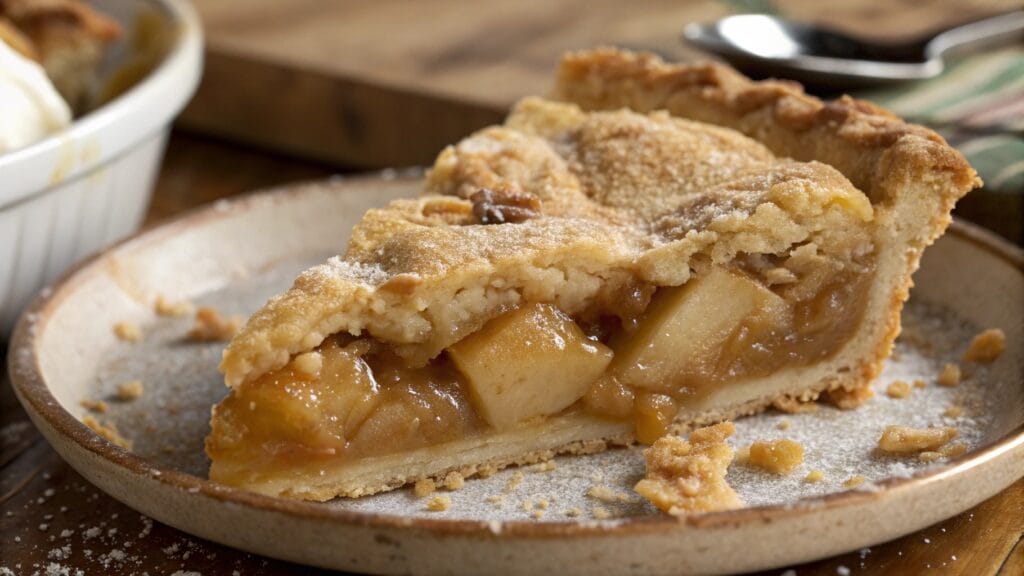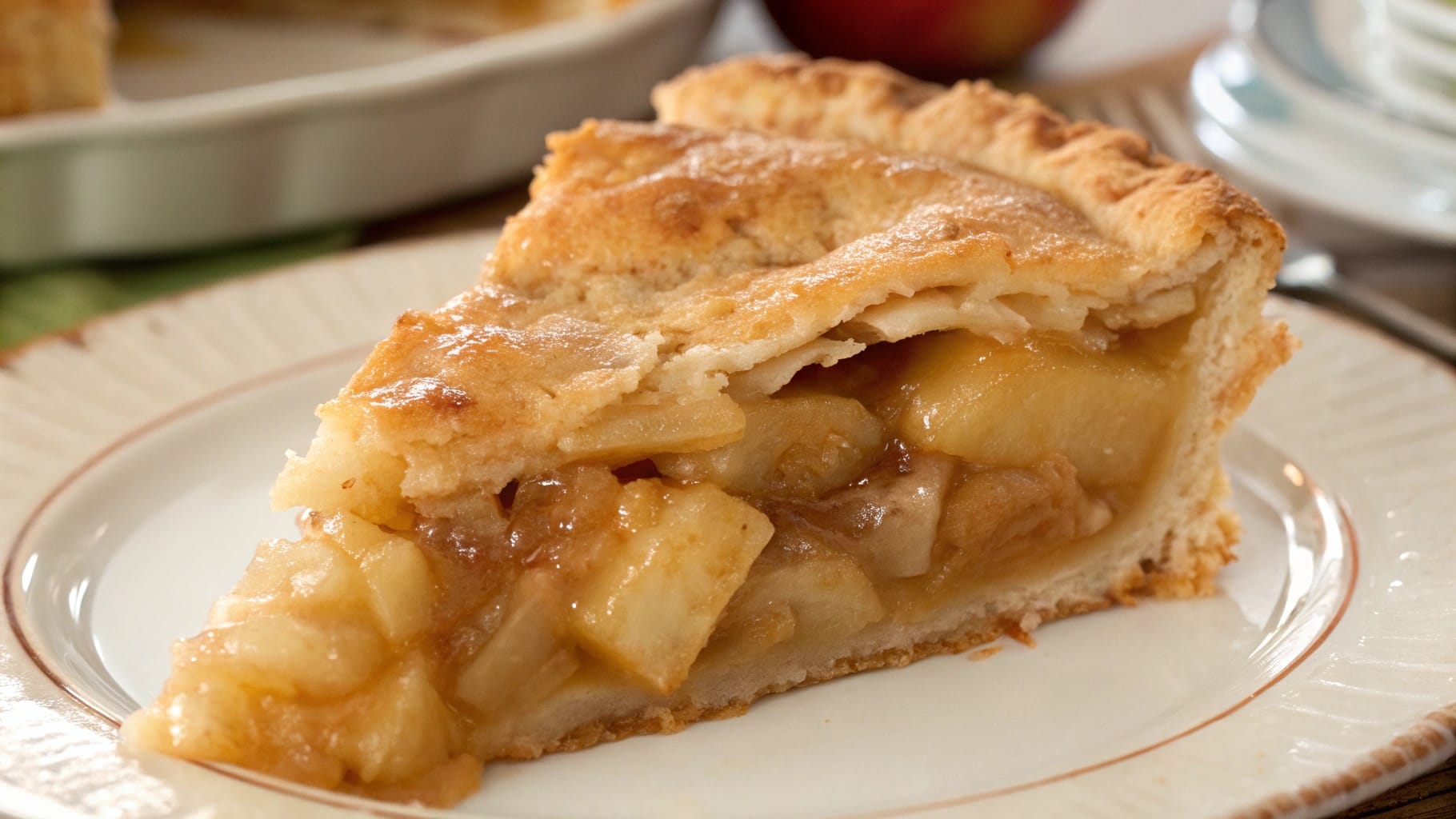Introduction
Apple pie filling is a delicious treat that makes the perfect base for your homemade pies. Whether you’re preparing a classic dessert or experimenting with different variations, the right apple pie filling recipe is key. It combines the right apples, spices, and sweeteners to create a mouthwatering filling that is both flavorful and satisfying.
Ingredients for Apple Pie Filling
To make a delicious apple pie filling, you’ll need a few basic ingredients. Below is a list of essential items to get started:
- Apples: Choose the right variety for the best texture and flavor.
- Sugar: Adds the sweetness to balance the tartness of the apples.
- Cinnamon: This classic spice brings warmth and depth to the filling.
- Nutmeg: A subtle spice that complements cinnamon.
- Lemon juice: Enhances the freshness of the apples.
- Thickening agent: Cornstarch or flour helps create a smooth, thick filling.
These ingredients come together to create a rich and flavorful apple pie filling that will impress everyone who tastes it. The next step is choosing the best apples for the perfect filling.
Choosing the Best Apples for Pie Filling
The type of apples you choose plays a crucial role in the overall texture and flavor of your pie filling. Some apples break down easily when baked, while others hold their shape and texture better.
- Granny Smith: Tart and firm, these apples are a top choice for pie fillings.
- Honeycrisp: Sweet, juicy, and crisp, they offer a good balance of sweetness and tartness.
- Golden Delicious: Mildly sweet and tender, they pair well with other apples.
- Braeburn: They provide a mix of sweetness and tang, making them ideal for pie fillings.
Selecting the right apples ensures your apple pie filling has a perfect balance of sweetness and texture. Now that we’ve got the right apples, let’s prepare them.
How to Prepare Apples for the Filling
Preparing your apples properly is essential for a successful apple pie filling. Start by peeling and coring the apples. Then, slice them into thin, even pieces to ensure they cook evenly.
- Peel each apple using a vegetable peeler.
- Cut the apple in half and remove the core with an apple corer or knife.
- Slice the apples into uniform pieces, making sure they’re not too thick or too thin.
Once the apples are prepared, it’s time to add the sweeteners and spices. Let’s explore the perfect sweetener for your apple pie filling.
The Perfect Sweetener: Sugar and Alternatives
The right sweetener can make or break your apple pie filling. While traditional sugar is a popular choice, there are several alternatives you can use to customize the flavor.
- Granulated sugar: The classic choice for sweetness.
- Brown sugar: Adds a rich, caramel-like flavor to the filling.
- Maple syrup: A natural alternative that brings a unique flavor.
- Honey: Offers a more complex sweetness and pairs well with cinnamon.
Choose the sweetener that best complements the apples you’ve selected. You can also experiment with a mix of sweeteners to find the balance that works best for you. With the right sweetener in place, let’s add some spices to enhance the flavor.
Spices That Enhance the Flavor of Apple Pie Filling
Spices are an essential component of any apple pie filling recipe. The combination of cinnamon, nutmeg, and other spices brings warmth and depth to the filling.
- Cinnamon: This spice is a must-have in any apple pie filling. It provides a comforting warmth and enhances the apple flavor.
- Nutmeg: Adds a subtle, sweet spice that pairs well with cinnamon.
- Allspice: A great alternative to cinnamon with hints of cloves and pepper.
- Cloves: A pinch of ground cloves can add a bold flavor to your pie filling.
Incorporating these spices into your apple pie filling will give it that signature comforting taste. Now, let’s talk about the thickening agents that help bring everything together.
The Role of Thickening Agents in Apple Pie Filling
A thickening agent is important to ensure your apple pie filling has the right texture. It prevents the filling from being too runny or too watery.
- Cornstarch: A common choice, it thickens the filling without altering the flavor.
- Flour: Another option, flour creates a slightly different texture, making the filling more like a custard.
- Tapioca: This option works well for a clearer filling and helps prevent a soggy crust.
- Arrowroot: A natural thickening agent that provides a smooth, glossy finish.
Choosing the right thickening agent depends on your preference for texture and consistency. Once you’ve selected the ideal thickener, your filling will come together nicely. Let’s finish by wrapping up the process.
Apple Pie Filling Recipe: Tips and Techniques
An apple pie filling recipe is versatile and can be adapted to many cooking methods. Whether you’re making a classic pie or using the filling for other dishes, knowing how to prepare, store, and use apple pie filling is essential for a successful outcome. In this guide, we’ll explore various methods for cooking, storing, and even freezing apple pie filling to suit your needs.

Cooking Methods for Apple Pie Filling
There are several ways to cook your apple pie filling before adding it to your crust. The cooking method you choose can affect the texture and flavor of your filling.
- Stovetop: One of the quickest methods, stovetop cooking helps the apples soften and absorb the spices and sweeteners. Cook the apples over medium heat, stirring frequently until tender.
- Baking: Baking the apple filling in the oven allows the spices to meld and gives a caramelized flavor to the apples. You can bake the filling for about 15 minutes before placing it in the pie shell.
- Slow Cooker: If you prefer a hands-off approach, the slow cooker is an excellent choice. Set it to low heat and cook the apple pie filling for several hours until the apples are soft and syrupy.
These methods allow you to choose the one that best fits your schedule and preference. Once your apple pie filling is ready, it’s time to store it for future use.
Storing Apple Pie Filling for Later Use
Storing apple pie filling is a convenient way to have it ready for future baking. Proper storage will preserve the flavor and texture, ensuring your pie is always delicious.
- Refrigeration: If you plan to use the filling within a few days, store it in an airtight container in the refrigerator. It will last for up to 4-5 days.
- Freezer Storage: For longer storage, freeze the apple pie filling. Make sure to place it in a freezer-safe bag or container, and remove as much air as possible to avoid freezer burn. Frozen apple pie filling can last up to 6 months.
- Jar Storage: Another option is to store the filling in jars, especially if you plan to can it for long-term storage.
Now that you know how to store apple pie filling, let’s explore how you can preserve it for long-term use.
Canning Apple Pie Filling for Long-Term Storage
Canning is a great way to preserve apple pie filling for long-term use. By canning your filling, you can keep it in your pantry for months, or even longer, and have it ready whenever you need it.
- Prepare the filling: Cook your apple pie filling according to the recipe, but leave the thickening agent out until you’re ready to use the filling.
- Sterilize the jars: Before canning, sterilize your jars and lids by boiling them for 10 minutes.
- Fill the jars: Once the jars are sterilized, carefully pour the hot apple pie filling into each jar, leaving about 1 inch of headspace.
- Process the jars: Seal the jars and process them in a water bath canner for about 25 minutes. This will ensure a proper seal.
- Store: Once the jars have cooled, store them in a cool, dark place. Your apple pie filling can last up to a year.
Canning is a perfect option if you want to have apple pie filling on hand for the future. But what if you need the filling quickly? Freezing it could be your answer.
Freezing Apple Pie Filling: A Step-by-Step Guide
Freezing apple pie filling is a great way to preserve it for future use. The process is simple and helps keep the filling fresh for months. Here’s how to do it:
- Prepare the filling: Cook the apples and spices, but skip the thickener. This prevents the filling from becoming too watery when frozen.
- Cool the filling: Allow the apple pie filling to cool completely before freezing.
- Pack the filling: Transfer the cooled filling into freezer-safe bags or containers. Leave some space for the filling to expand as it freezes.
- Seal and label: Seal the bags tightly and label them with the date so you can keep track of storage time.
- Freeze: Place the bags or containers in the freezer. The filling will stay fresh for up to 6 months.
Once frozen, your apple pie filling is ready whenever you need it. Simply thaw and add it to your pie crust for a quick dessert. But, while freezing works well, it’s important to avoid common mistakes when making apple pie filling.
Common Mistakes to Avoid When Making Apple Pie Filling
While preparing apple pie filling is simple, there are a few common mistakes that can affect the final product. By avoiding these pitfalls, you’ll end up with a perfect filling every time.
- Not choosing the right apples: Some apples break down too much during cooking, leading to mushy filling. Opt for firmer varieties like Granny Smith or Honeycrisp for the best results.
- Overcooking the apples: If you cook the apples for too long, they’ll become too soft and lose their texture. Aim for just tender apples that still hold some shape.
- Skipping the thickener: If you forget the thickener or use too little, your filling may turn out too runny. Be sure to use the right amount of cornstarch or flour to get a thick consistency.
- Under-seasoning: Spices are essential for flavor. Don’t skimp on cinnamon, nutmeg, and other spices to enhance the taste.
By avoiding these mistakes, you’ll ensure that your apple pie filling turns out perfectly every time. Now that you have your apple pie filling ready, let’s explore some creative ways to use it beyond pies.
Creative Ways to Use Apple Pie Filling Besides Pies
While apple pie is the classic way to use your filling, there are many other creative ways to enjoy it. Here are a few ideas:
- Apple crisp: Use your apple pie filling as the base for a delicious apple crisp. Top it with oats, brown sugar, and butter for a crunchy, sweet topping.
- Apple dumplings: Wrap your apple pie filling in dough and bake for individual apple dumplings.
- Apple turnovers: Use puff pastry to create flaky, delicious apple turnovers filled with your pie filling.
- Apple pancakes: Top your pancakes with warmed apple pie filling for a sweet breakfast treat.
- Apple-filled pastries: Use the filling to stuff croissants, Danish pastries, or other baked goods for a delicious twist.
These creative uses are perfect if you have leftover apple pie filling or simply want to try something new. Now, let’s wrap up everything we’ve covered.
FAQs
Should you cook apples before putting them in a pie?
It’s not necessary to cook apples before placing them in a pie. However, cooking them slightly can help soften the apples and allow the spices and sugars to blend better. Many people prefer to cook the apple pie filling on the stove before filling the crust, as it results in a thicker, more flavorful filling.
What to put in apple pie filling?
In an apple pie filling, you’ll need apples, sugar, spices like cinnamon and nutmeg, and a thickener. Commonly, lemon juice is added to balance the sweetness and enhance the apple flavor. You may also use brown sugar for a richer taste or maple syrup for a natural sweetness. Lastly, choose the right thickener, such as cornstarch, flour, or tapioca, to get the perfect consistency.
What is the best thickener for apple pie filling?
The best thickener for apple pie filling largely depends on your preferences. Cornstarch is a popular choice because it creates a smooth and clear filling. If you prefer a more substantial texture, flour is a great option. Tapioca is another effective thickener that gives the filling a nice, glossy finish without altering the flavor.
What is the secret to a good apple pie?
The secret to a good apple pie lies in using the right apples, balancing the sweetness, and adding the perfect amount of spices. Additionally, don’t forget the importance of a well-made crust. A buttery, flaky crust complements the filling perfectly. Finally, allow the pie to cool slightly after baking so the filling can set, giving you a slice that holds its shape beautifully.
Conclusion
An apple pie filling recipe is more than just a filling for pies—it can be stored, frozen, and used in many creative ways. From stovetop cooking to canning and freezing, there are many methods to preserve and prepare apple pie filling for any occasion. Avoid common mistakes, and be sure to store your filling properly for maximum flavor and texture.
Whether you’re baking a pie, making apple crisp, or trying a new dessert, apple pie filling is a versatile and delicious addition to your cooking repertoire. Happy baking and enjoy exploring all the ways you can use this classic filling! For more delicious pie ideas, check out The Ultimate Guide to Making Pecan Pie: Tips, Recipes, and More.

